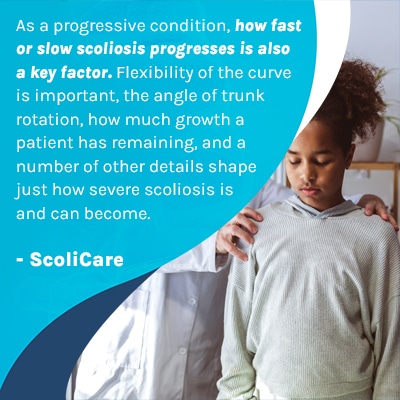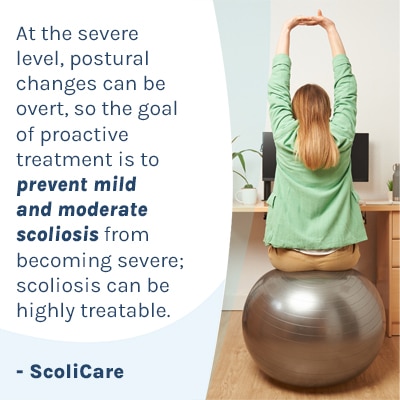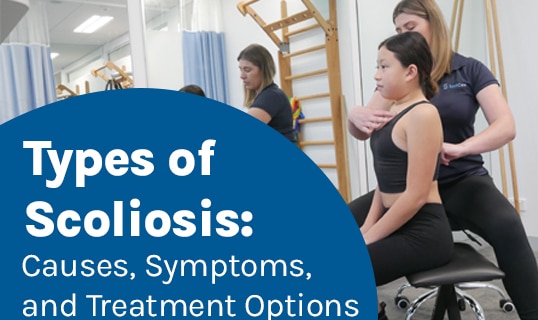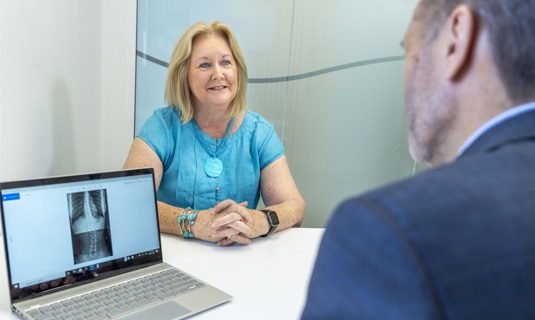What patients need to understand about severe scoliosis is that it doesn’t start that way; as a progressive condition, scoliosis severity can increase over time, and while young patients can progress quickly, there is a lot that can be done to counteract the progressive nature of scoliosis.
Severe scoliosis is diagnosed when the spine has developed an unnatural lateral spinal curvature that rotates and has a Cobb angle measurement of 40+ degrees. Most cases of scoliosis are idiopathic, and severe scoliosis symptoms can include postural/movement changes and pain.
Before getting to the specifics of severe scoliosis, let’s explore what condition severity actually means.
Scoliosis Severity: What Does it Mean?
When a patient comes to a ScoliCare Clinic for an initial assessment, it’s comprehensive because the information collected is what treatment plans are based on, and the more accurate and precise the information is, the more potential there is for treatment results to be as precise and successful.
No treatment guarantees can ever be given; there are a number of factors that shape a patient’s treatment response, and accuracy of the information collected during the initial assessment is the first step to designing a potentially-effective individualized treatment plan.
So what are the severity levels of scoliosis, and how are they determined? Scoliosis ranges in severity from mild scoliosis to moderate and severe scoliosis (1).
The main determining factor is a patient’s Cobb angle, and this is a measurement taken during a scoliosis X-ray. Cobb angle refers to how unnaturally tilted the vertebrae are at the apex of the abnormal spinal curvature (1).
The higher a patient’s Cobb angle, the more out of alignment the spine is, and the more severe the scoliosis is; however, it’s important to understand that curve size isn’t the only indicator of severity.
Scoliosis Progression
 As a progressive condition, how fast or slowly scoliosis progresses is also a key factor. Flexibility of the curve is important, the angle of trunk rotation, how much growth a patient has remaining, and a number of other details shape just how severe scoliosis is and can become.
As a progressive condition, how fast or slowly scoliosis progresses is also a key factor. Flexibility of the curve is important, the angle of trunk rotation, how much growth a patient has remaining, and a number of other details shape just how severe scoliosis is and can become.
For example, we know that a single curve in the thoracic spine is more prone to rapid advancement, so a diagnosis of mild thoracic scoliosis has the potential to become moderate and/or severe more quickly than other curve types diagnosed as mild, so this has to be factored into treatment.
Scoliosis progression is triggered by growth, so children can face rapid progression due to growth spurts (2).
If a child is initially diagnosed with mild scoliosis, while the term mild can suggest the condition isn’t overly serious and that there is time to decide on a course of treatment, this isn’t the case, particularly for young patients with a lot of bone growth remaining (2).
So while Cobb angle is considered to be the gold standard in determining condition severity, it’s not just the size of the curve that matters, but also its flexibility, rotation, location, and a number of other factors that shape how a patient will experience their scoliosis, and regardless of severity, the best time to act is always now (1, 2).
Scoliosis ranges in severity from mild to severe scoliosis, and what’s important to understand is that the severity levels are also the path of progression, so many cases that become severe can do so over time, and a lot can be done in the interim, particularly if diagnosed and treated proactively.
Let’s now talk about causation, as this is an important factor when it comes to individualizing treatment plans and the type of symptoms and rates of progression a patient is likely to experience.
What Causes Severe Scoliosis?
What causes scoliosis to become severe is progression, but in many cases, progression can be managed and/or prevented.
So scoliosis progression can also occur due to lack of treatment and/or lack of proactive specialized treatment, but there are also different types of scoliosis to consider.
The most common type of scoliosis is idiopathic scoliosis, with no clear cause, and the majority of scoliosis cases are idiopathic.
The most prevalent type of scoliosis overall is adolescent idiopathic scoliosis diagnosed between 10 and 18 years of age, and because of puberty and its rapid growth spurts, adolescents are the most at risk for rapid progression (3).
Adolescents diagnosed with mild scoliosis need to understand that scoliosis isn’t a static condition, and without treatment, due to growth and progression, mild scoliosis can quickly become moderate and then severe scoliosis (2, 3).
Scoliosis types with known causes are considered atypical and often have different characteristics than typical cases of idiopathic scoliosis: neuromuscular scoliosis, degenerative scoliosis, and congenital scoliosis (4).
Most types of scoliosis can become severe if left untreated, but when there is an underlying pathology involved, these types of scoliosis can progress from mild to severe more quickly than in typical cases.
Severe Scoliosis with Known Causes
Neuromuscular scoliosis cases can be challenging to address because the scoliosis develops as a secondary complication of a serious neuromuscular condition or spinal muscular atrophy (4).
Having a neuromuscular condition like spina bifida, cerebral palsy, or muscular dystrophy doesn’t guarantee the development of scoliosis, but it is a common complication as there is already a disruption in the brain’s ability to communicate with the spine and its surrounding muscles and connective tissues (4).
So these cases can become severe quickly, and lack of treatment can lead to progression that doesn’t just increase the curve size, but also further interrupts posture and quality of life.
Degenerative scoliosis affects older adults, and these cases can be particularly painful because they’re caused by degeneration that’s occurring in the spine; this can be natural and age-related, but lifestyle factors can also contribute to a person’s rate and level of age-related degenerative changes (5).
Because there can be so much instability and movement in a degenerating spine, cases of degenerative scoliosis can progress quickly and require pain management (5).
Congenital scoliosis is a rare type affecting infants whose scoliosis develops due to malformed vertebrae that affect the spine’s ability to develop properly.
So now that we’ve covered severe scoliosis causes and the different types of scoliosis, let’s discuss some common symptoms scoliosis patients experience.
Severe Scoliosis Symptoms
Because there are different types and severity levels of scoliosis, symptoms can vary widely, but as severe scoliosis involves larger curves and can indicate that a significant amount of progression has already occurred, severe scoliosis symptoms tend to be noticeable.
Severe cases can involve noticeable postural changes: the head not being centered over the torso, uneven shoulders, shoulder blades, a rib cage arch, uneven hips, uneven arm- and leg-length, and a prominent lean to one side.
Severe scoliosis patients often experience changes to the way clothes fit and hang on the body as the condition’s asymmetrical nature can disrupt the body’s overall symmetry.
 At the severe level, postural changes can be overt, so the goal of proactive treatment is to prevent mild and moderate scoliosis from becoming severe; scoliosis can be highly treatable.
At the severe level, postural changes can be overt, so the goal of proactive treatment is to prevent mild and moderate scoliosis from becoming severe; scoliosis can be highly treatable.
Movement changes can also be expected including changes to balance, coordination, gait and proprioception.
Scoliosis Pain
While growing spines can counteract the compressive force of scoliosis, once growth stops and skeletal maturity has been reached, compression can make scoliosis painful.
While some cases of severe scoliosis in children aren’t described as painful, for adults, severe scoliosis treatment includes pain management as a focus (5).
Severe scoliosis pain can be chronic and affect the muscles, the back, and cause nerve pain that radiates into the extremities; if left untreated, severe scoliosis patients are at risk for continued progression, increasing pain levels, and developing complications like digestive, lung, and cardiac issues.
The best way to manage scoliosis symptoms is to proactively work towards their prevention because once they develop and the longer they’re established, the more the body compensates, and the harder it can be to improve and/or reverse their effects.
Severe Scoliosis Treatment Options
When it comes to addressing scoliosis with treatment, the type of treatment is important because it will affect how the spine functions in the future (6, 7).
Here at ScoliCare, conservative treatment has many goals, but a main focus is to manage progression so patients diagnosed with mild and moderate scoliosis don’t progress into the severe level; this means avoiding increasing symptoms and the potential for a surgical recommendation in the future (6).
Another goal of a conservative treatment approach is to restore spinal alignment because a misaligned spine can disrupt the symmetry, balance, and stability of the entire body.
Severe curves need to be addressed so they don’t continue progressing, and even severe cases can benefit from what scoliosis-specific exercise and corrective bracing can achieve when combined (7).
ScoliBalance® is ScoliCare’s highly-specialized scoliosis-specific exercise program that uses the power of physical therapy and exercise to slow/stop progression, increase the spine’s flexibility and strength, and improve the spine’s surrounding muscle balance and strength so the spine support/stability are improved (7).
Postural restoration is also important, and through the use of customized Mirror Image® exercises, patients are taught how to hold the spine and body to best counteract their curve, and this type of awareness can help sustain treatment results and cultivate a spine-friendly lifestyle.
As the world’s most advanced scoliosis brace, the ScoliBrace® has potential to help reposition the spine, particularly when it’s integrated into a proactive conservative treatment plan that has the goal of preventing mild and moderate scoliosis from becoming severe scoliosis (7).
While surgical treatment can also be recommended for severe cases, what ScoliCare Clinicians want to ensure patients and parents fully understand is that not all cases of scoliosis have to become severe, but treatment is needed to keep scoliosis mild and/or prevent it from progressing with growth (2, 8).
Conclusion
So what is severe scoliosis? Severe scoliosis is diagnosed if an unnatural curvature of the spine that also rotates and has a Cobb angle of 40+ degrees has developed.
While a patient’s Cobb angle is important because this indicates the size of the unnatural spinal curve, additional important factors that should be considered are spinal maturity, curve type, location, flexibility, and the angle of rotation (ATR).
Scoliosis curve progression can often be managed, and in many cases, prevented, but in order to prevent an abnormal curvature from becoming larger and more severe, a patient’s initial assessment needs to be accurate and comprehensive and treatment plans need to be proactive.
References:
- Wang, J., Zhang, J., Xu, R. et al. Measurement of scoliosis Cobb angle by end vertebra tilt angle method. J Orthop Surg Res 13, 223 (2018). https://doi.org/10.1186/s13018-018-0928-5
- Negrini S, Donzelli S, Aulisa AG, Czaprowski D, Schreiber S, de Mauroy JC, Diers H, Grivas TB, Knott P, Kotwicki T, Lebel A, Marti C, Maruyama T, O’Brien J, Price N, Parent E, Rigo M, Romano M, Stikeleather L, Wynne J, Zaina F. 2016 SOSORT guidelines: orthopaedic and rehabilitation treatment of idiopathic scoliosis during growth. Scoliosis Spinal Disord. 2018 Jan 10;13:3. doi: 10.1186/s13013-017-0145-8. PMID: 29435499; PMCID: PMC5795289.
- Weinstein SL. The Natural History of Adolescent Idiopathic Scoliosis. J Pediatr Orthop. 2019 Jul;39(Issue 6, Supplement 1 Suppl 1):S44-S46. doi: 10.1097/BPO.0000000000001350. PMID: 31169647.
- Wishart BD, Kivlehan E. Neuromuscular Scoliosis: When, Who, Why and Outcomes. Phys Med Rehabil Clin N Am. 2021 Aug;32(3):547-556. doi: 10.1016/j.pmr.2021.02.007. Epub 2021 May 12. PMID: 34175013.
- Marty-Poumarat, Catherine MD*; Scattin, Luciana MD†; Marpeau, Michèle MD*; Garreau de Loubresse, Christian MD‡; Aegerter, Philippe MD, PhD§. Natural History of Progressive Adult Scoliosis. Spine 32(11):p 1227-1234, May 15, 2007. | DOI: 10.1097/01.brs.0000263328.89135.a6
- Comparison of Functional Outcome and Quality of Life in Patients With Idiopathic Scoliosis Treated by Spinal Fusion: National Library of Medicine
- Marchese R, Du Plessis J, Pooke T, McAviney J. The Improvement of Trunk Muscle Endurance in Adolescents with Idiopathic Scoliosis Treated with ScoliBrace® and the ScoliBalance® Exercise Approach. J Clin Med. 2024 Jan 23;13(3):653. doi: 10.3390/jcm13030653. PMID: 38337346; PMCID:


